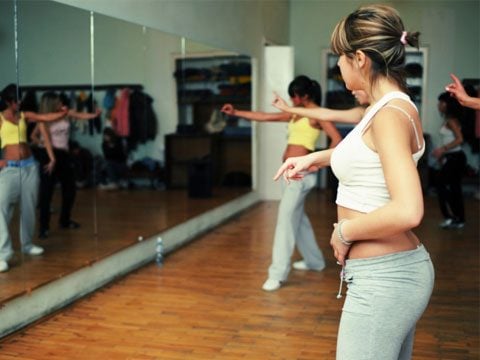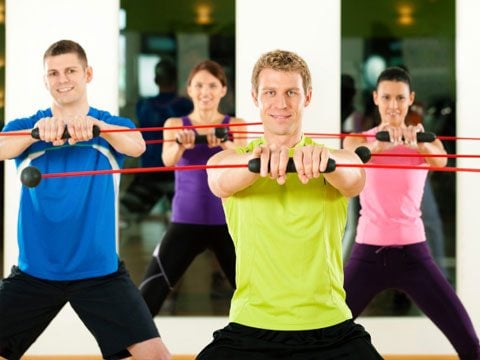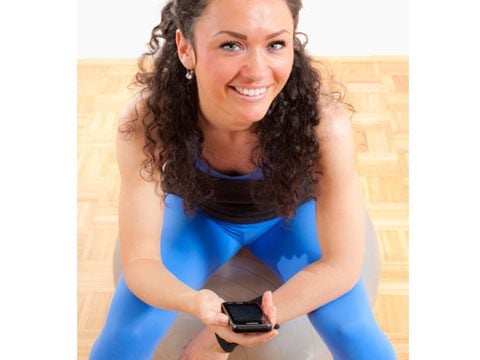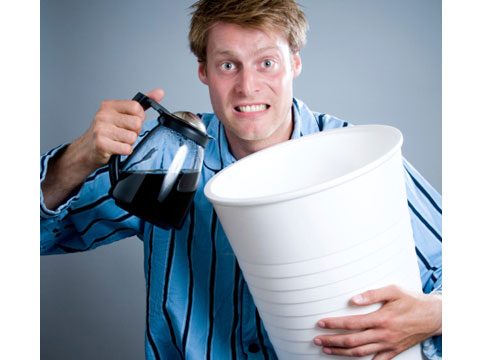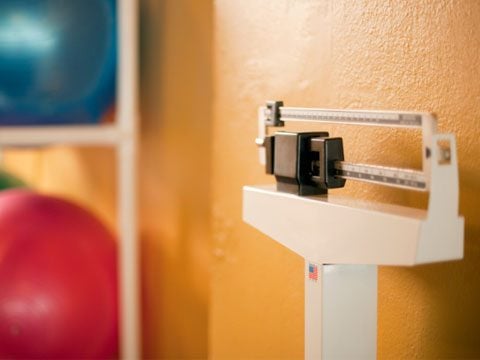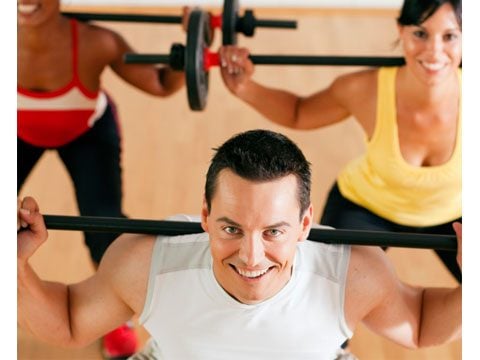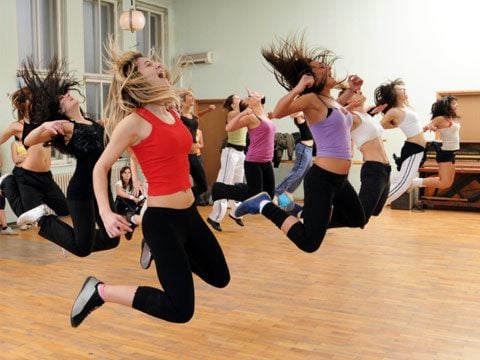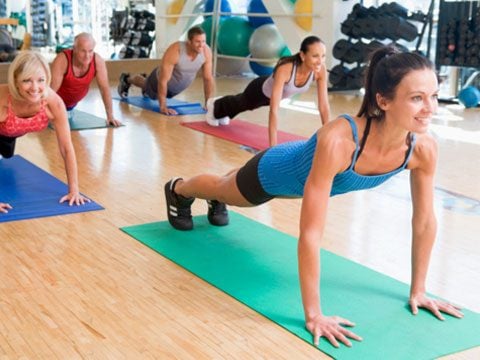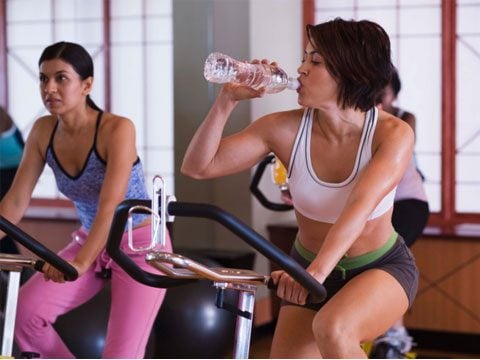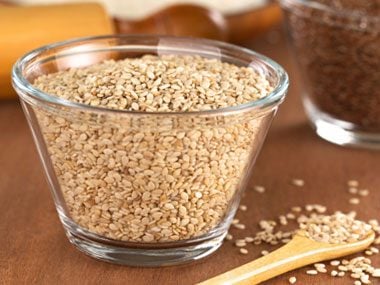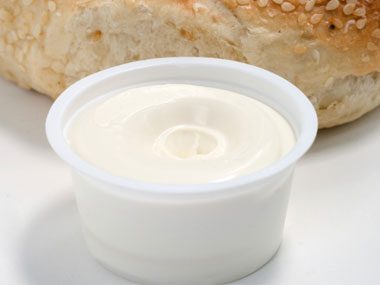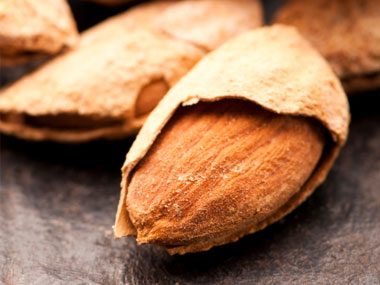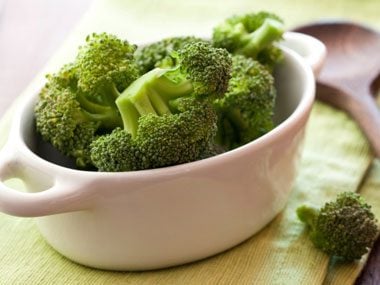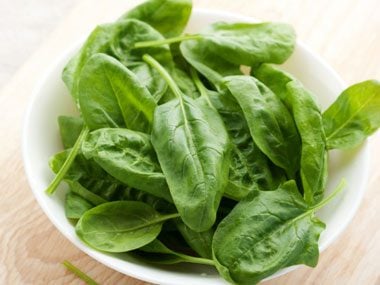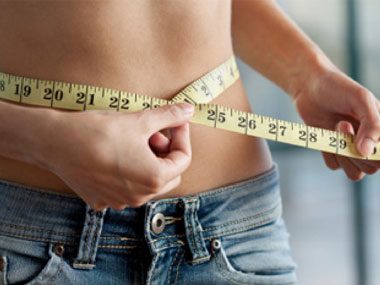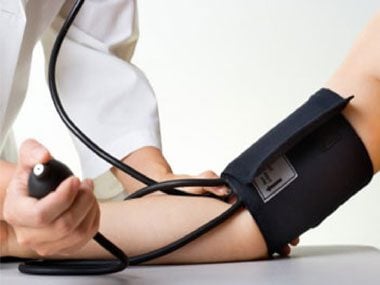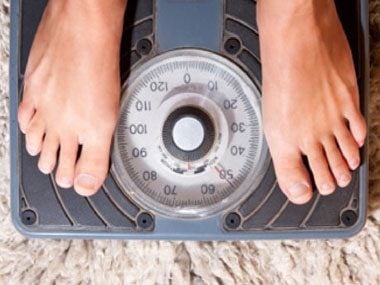The Top Thigh Exercises To Help Slim Them Down
Gym Exercises
Before starting your exercises, make sure you properly warm-up your legs by doing something that will heat up the muscles and prepare them for weight training. Walking on the treadmill or riding the stationary cycle for 10 minutes are great warmup exercises.
Leg Press
The leg press will work both the front and back of your thigh, so it’s the perfect exercise to start with.
There are different varieties of this machine, but for beginners it’s best to use a horizontal or seated leg press. This machine has an upright seat (like a regular chair) and is attached to a weight stack.
Once seated, place your feet shoulder-width apart on the crosspiece (the footrest that you rest your feet against to activate the weight resistance) with your toes pointing forward.
Then push all the way out until your legs are almost extended, but do not lock your knees.
According to Acefitness.org, locking your knees can result in an injury to your joints, so don’t forget to always allow a slight bend in your knees when extending your legs. Return the weight slowly until your knees are at a 90 degree angle. That’s one full repetition. Easy, isn’t it?
Once you have mastered the horizontal leg press, try challenging yourself on the angled leg press. This machine is used in the same fashion, but only this time you’ll be seated vertically so your back is parallel to the floor. The angled leg press will allow you to add your own weight plates (which can be more difficult) and in turn, provide greater results.
If you’re having trouble carrying the weights to the machine on your own, then don’t hesitate to ask anyone in the gym for help - men are usually more than willing to show off their own muscles.
Once your legs are in position and ready to go, push up until your legs are extended. Then release the safety bar and bend your knees so that your thighs are perpendicular to your lower legs (your legs will be bent just as they are when sitting in a chair.) Once you complete a set, make sure you remember to secure the safety bar.
Leg Extension
This leg exercise will tone your quadriceps, which is the muscle at the front of the thigh. Your quadriceps (or quads as they are commonly referred to) is the muscle that people see when they first look at your legs so you’ll want to make toning this muscle a priority.
There should be at least one leg extension machine in every gym, so you won’t have a problem finding this machine. The leg extension is a machine where you sit on a chair with your knees bent and your ankles are placed behind a padded bar that is connected to a weight stack. The idea is to extend your legs until they are straight by lifting the padded bar with your legs.
This will engage your quadriceps and you’ll notice the muscle begin to flex. Your quads are stronger than you think so try and push yourself harder each time.
The easiest way to perform a squat is to lean against the wall. Stand with your feet shoulder-width apart and approximately 2 feet away from the wall before sliding down until you are in a sitting position or until your thighs are parallel to the floor. Hold this position for as long as you can, but aim for 20 seconds before rising back up.
Traditional Squats
Plie squat
Lunges
http://www.lifescript.com/diet-fitness/articles/t/the_top_thigh_exercises_to_help_slim_them_down.aspx
Some women are born blessed with slim thighs, but then there are the rest of us that have to work hard to achieve results with thigh exercises. Athletes make it look easy, but they didn’t roll out of bed one day looking fit and ready to tackle the world of professional sports; they train hard and, as a result, have nicely toned legs. Don’t worry, you won’t have to spend your days and nights in the gym slimming down your thighs, but you will need a bit of dedication if you want to look fabulous in your shorts. Of course, being naturally slender helps, but even more robust women can lose inches on their legs. By following the thigh exercises listed below, you’ll be on your way to slimmer legs in no time.
Leg exercises can be done either at the gym or at home, but for the best results you’ll want to use a combination of both. Aim for three sets of 12 to 15 repetitions per exercise.
Before you start, make sure you have a professional staff member show you how to use the gym equipment. Performing exercises for your thighs sounds easy enough, but you don’t want to risk injuring yourself by using the machines incorrectly.
Leg exercises can be done either at the gym or at home, but for the best results you’ll want to use a combination of both. Aim for three sets of 12 to 15 repetitions per exercise.
Before you start, make sure you have a professional staff member show you how to use the gym equipment. Performing exercises for your thighs sounds easy enough, but you don’t want to risk injuring yourself by using the machines incorrectly.
If you want to see pictures of what the gym machines look like or watch an instructional video, then try learning from the pros at Bodybuilding.com.
If you want to track your progress, consider having the trainer at the gym measure your body fat with a caliper every week. Muscle weighs more than fat, so don’t worry if you gain some weight, just as long as it’s from your new muscles and not from eating jelly donuts.
If you want to track your progress, consider having the trainer at the gym measure your body fat with a caliper every week. Muscle weighs more than fat, so don’t worry if you gain some weight, just as long as it’s from your new muscles and not from eating jelly donuts.
Gym Exercises
Before starting your exercises, make sure you properly warm-up your legs by doing something that will heat up the muscles and prepare them for weight training. Walking on the treadmill or riding the stationary cycle for 10 minutes are great warmup exercises.
Leg Press
The leg press will work both the front and back of your thigh, so it’s the perfect exercise to start with.
There are different varieties of this machine, but for beginners it’s best to use a horizontal or seated leg press. This machine has an upright seat (like a regular chair) and is attached to a weight stack.
Once seated, place your feet shoulder-width apart on the crosspiece (the footrest that you rest your feet against to activate the weight resistance) with your toes pointing forward.
Then push all the way out until your legs are almost extended, but do not lock your knees.
According to Acefitness.org, locking your knees can result in an injury to your joints, so don’t forget to always allow a slight bend in your knees when extending your legs. Return the weight slowly until your knees are at a 90 degree angle. That’s one full repetition. Easy, isn’t it?
Once you have mastered the horizontal leg press, try challenging yourself on the angled leg press. This machine is used in the same fashion, but only this time you’ll be seated vertically so your back is parallel to the floor. The angled leg press will allow you to add your own weight plates (which can be more difficult) and in turn, provide greater results.
If you’re having trouble carrying the weights to the machine on your own, then don’t hesitate to ask anyone in the gym for help - men are usually more than willing to show off their own muscles.
Once your legs are in position and ready to go, push up until your legs are extended. Then release the safety bar and bend your knees so that your thighs are perpendicular to your lower legs (your legs will be bent just as they are when sitting in a chair.) Once you complete a set, make sure you remember to secure the safety bar.
Leg Extension
The leg extension is a must for anyone trying to tone their thighs. It is an easy starter exercise for beginners, but with added weight it can also be challenging for body builders.
This leg exercise will tone your quadriceps, which is the muscle at the front of the thigh. Your quadriceps (or quads as they are commonly referred to) is the muscle that people see when they first look at your legs so you’ll want to make toning this muscle a priority.
There should be at least one leg extension machine in every gym, so you won’t have a problem finding this machine. The leg extension is a machine where you sit on a chair with your knees bent and your ankles are placed behind a padded bar that is connected to a weight stack. The idea is to extend your legs until they are straight by lifting the padded bar with your legs.
This will engage your quadriceps and you’ll notice the muscle begin to flex. Your quads are stronger than you think so try and push yourself harder each time.
Leg Curl
It’s no good slimming the front of your legs if you’re not going to tone the back, so make sure you use the leg curl, which will work your hamstrings (the muscles at the back of your thigh).
There are a few different types of leg curl machines: the seated leg curl, the standing leg curl, and the lying leg curl. The seated leg curl is suited for people of all heights, so it’s the best place to start. If your gym has all three machines, then why not try them all out.
The seated leg curl is a machine where you sit on a chair and place your legs straight out in front of you – your ankles should be placed over a padded bar attached to a weight stack. This is very similar to the leg extension except you’ll be pushing your legs downwards instead of upwards to engage the hamstring muscle.
Your hamstring muscles are often overlooked when stretching, so make sure you stretch in-between sets.
A good way to stretch this muscle is to grab your left foot with your left hand by bending your knee, then grab a bar or rail with your right hand to maintain your balance and lean over as far as you can. Hold this stretch for at least 10 seconds before switching to the other side.
There are a few different types of leg curl machines: the seated leg curl, the standing leg curl, and the lying leg curl. The seated leg curl is suited for people of all heights, so it’s the best place to start. If your gym has all three machines, then why not try them all out.
The seated leg curl is a machine where you sit on a chair and place your legs straight out in front of you – your ankles should be placed over a padded bar attached to a weight stack. This is very similar to the leg extension except you’ll be pushing your legs downwards instead of upwards to engage the hamstring muscle.
Your hamstring muscles are often overlooked when stretching, so make sure you stretch in-between sets.
A good way to stretch this muscle is to grab your left foot with your left hand by bending your knee, then grab a bar or rail with your right hand to maintain your balance and lean over as far as you can. Hold this stretch for at least 10 seconds before switching to the other side.
Home Exercises
Wall Squat
Wall Squat
Traditional Squats
Squats can be performed with or without weights, so they’re the perfect at-home exercise. These thigh exercises only take a few minutes and can work wonders when trying to slim down your legs.
If this is your first time doing squats, then you might want to stand in front of a mirror so you can make sure you’re using the correct form.
Stand straight with your feet shoulder-width apart. Inhale deeply and bend your legs slowly at the knee so your legs are parallel with the floor (as if you are about to sit in a chair). Try not to hunch your shoulders or bend your back; keeping your back straight and sticking out your butt out are the best way to perform a squat, according to Acefitness.org. Try to keep a slight bend in your knees as you exhale and come back up by straightening your legs.
Squats can be performed with your arms straight out in front of your body or with weights by your side. If you don’t have dumbbells at home, then try using a plastic bottle of juice or even a can of sauce.
If this is your first time doing squats, then you might want to stand in front of a mirror so you can make sure you’re using the correct form.
Stand straight with your feet shoulder-width apart. Inhale deeply and bend your legs slowly at the knee so your legs are parallel with the floor (as if you are about to sit in a chair). Try not to hunch your shoulders or bend your back; keeping your back straight and sticking out your butt out are the best way to perform a squat, according to Acefitness.org. Try to keep a slight bend in your knees as you exhale and come back up by straightening your legs.
Squats can be performed with your arms straight out in front of your body or with weights by your side. If you don’t have dumbbells at home, then try using a plastic bottle of juice or even a can of sauce.
Plie squat
Admit it, when you were little you wanted to be a ballerina, right? Well here’s your chance to do a plie, but instead of performing on the stage, you’ll be strengthening and toning your inner thighs (that pesky area that seems to wobble and rub together). The plie squat is also a great way to improve your coordination. If you have trouble at first, try holding onto something like a countertop.
While standing, spread your legs as far as you can so that your feet are farther away than your shoulders (at least 2 feet away from your body). The farther you spread your legs, the more you will work your inner thighs. Turn your feet, toes facing outwards.
Now here comes the tricky part; move your hips back and stick out your buttocks, then inhale and bend at the knee as far down as you can go. This is a real test of your balance but don’t worry, you don’t have to stay like that for too long. As soon as you go down as far as you can, then exhale and come back up slowly while still maintaining a straight torso.
If you want to really challenge yourself, try holding a dumbbell with both hands while your arms are hanging down in front of your body. If you can touch the dumbbell to the floor while performing the plie squat, then you know you’re a real pro!
While standing, spread your legs as far as you can so that your feet are farther away than your shoulders (at least 2 feet away from your body). The farther you spread your legs, the more you will work your inner thighs. Turn your feet, toes facing outwards.
Now here comes the tricky part; move your hips back and stick out your buttocks, then inhale and bend at the knee as far down as you can go. This is a real test of your balance but don’t worry, you don’t have to stay like that for too long. As soon as you go down as far as you can, then exhale and come back up slowly while still maintaining a straight torso.
If you want to really challenge yourself, try holding a dumbbell with both hands while your arms are hanging down in front of your body. If you can touch the dumbbell to the floor while performing the plie squat, then you know you’re a real pro!
Lunges
Lunges, like squats, can be performed anywhere and can be done with or without dumbbells. Lunges require a bit of coordination, but if you can walk, then rest assured you’ll be able to do a lunge.
The easiest way to get started with a lunge is to take a giant step forward with one leg and then bend at the knee all the way until your front leg is at a 90 degree angle. Hold this position for a few seconds then straighten your leg slowly before repeating the process with the other leg. You can do walking lunges if you have the room, if not, perform stationery lunges. Both exercises are equally effective.
Doing exercises for thighs is great for obtaining muscle tone, but don’t forget about the importance of proper nutrition and cardiovascular activity when it comes to losing fat.
Thigh exercises might seem like a lot of hard work, but once you get started you’ll see that they will be well worth it. You can perform lunges and squats just about anywhere (even while watching TV) so there’s really no excuse if you’re serious about slimming down your thighs.
Today’s styles are showing short shorts so you’ll be thankful when you go to try on your summer clothes and see how toned your legs have become. No more hiding behind a towel when it comes to walking on the beach, you worked hard for those trim, toned legs so now’s your chance to show them off!
What Do You Know About Leg Exercises?
The easiest way to get started with a lunge is to take a giant step forward with one leg and then bend at the knee all the way until your front leg is at a 90 degree angle. Hold this position for a few seconds then straighten your leg slowly before repeating the process with the other leg. You can do walking lunges if you have the room, if not, perform stationery lunges. Both exercises are equally effective.
Doing exercises for thighs is great for obtaining muscle tone, but don’t forget about the importance of proper nutrition and cardiovascular activity when it comes to losing fat.
Thigh exercises might seem like a lot of hard work, but once you get started you’ll see that they will be well worth it. You can perform lunges and squats just about anywhere (even while watching TV) so there’s really no excuse if you’re serious about slimming down your thighs.
Today’s styles are showing short shorts so you’ll be thankful when you go to try on your summer clothes and see how toned your legs have become. No more hiding behind a towel when it comes to walking on the beach, you worked hard for those trim, toned legs so now’s your chance to show them off!
What Do You Know About Leg Exercises?
You've got legs, but do you know how to use them? A cardio workout is certain to get your heart pumping, but it's the strength-training exercises that will help you achieve the slim, sleek and sexy legs that turn heads. Do you know what it takes to get great gams? It's time to put your best foot forward and see if you're making all the right moves with this leg exercises quiz.
http://www.lifescript.com/diet-fitness/articles/t/the_top_thigh_exercises_to_help_slim_them_down.aspx

